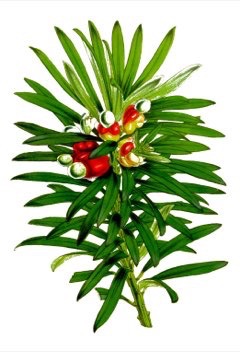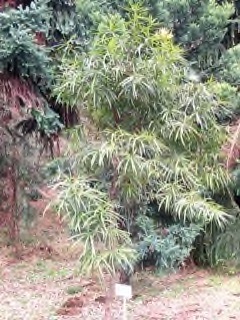 |
|
http://www.edibleplants.org |
 |
| Daderot wikimedia.org |
Translate this page:
Summary
Podocarpus neriifolius or otherwise known as Brown Pine is a tropical evergreen tree native to Southeast Asia that grows up to 45 m tall and 100 cm across. It has a dome-shaped canopy, cylindrical and straight trunk, and is buttressed for up to 2 m high. It is a dioecious species. The bark is grey-brown, scaly, and cracked. The leaves taper to the tip and are oval in shape. Leaf decoction is used as remedy for rheumatism and arthritis. Fruit is eaten raw. The wood is of high quality and used for general carpentry, boat making, furniture, musical instruments, and many more. Plants can be grown from seeds, layers, or cuttings. Germination rate is slow and can take up to a year or more.
Physical Characteristics

 Podocarpus neriifolius is an evergreen Tree growing to 25 m (82ft) by 25 m (82ft) at a medium rate.
Podocarpus neriifolius is an evergreen Tree growing to 25 m (82ft) by 25 m (82ft) at a medium rate.
See above for USDA hardiness. It is hardy to UK zone 10 and is frost tender. The species is dioecious (individual flowers are either male or female, but only one sex is to be found on any one plant so both male and female plants must be grown if seed is required). and is pollinated by Wind. The plant is not self-fertile.
Suitable for: light (sandy), medium (loamy) and heavy (clay) soils and prefers well-drained soil. Suitable pH: mildly acid and neutral soils and can grow in very acid and saline soils.
It can grow in semi-shade (light woodland) or no shade. It prefers moist soil and can tolerate drought. The plant can tolerates strong winds but not maritime exposure.
UK Hardiness Map
US Hardiness Map
Synonyms
Margbensonia neriifolia (D. Don) A.V.Bobrov & Melikyan Nageia discolor (Blume) Kuntze Nageia neglect
Plant Habitats
Edible Uses
Edible Parts: Fruit
Edible Uses:
Fruit - raw[46 , 404 ]. The orange-red fruit is about 8 - 10 _ 5 - 8mm[266 ].
References More on Edible Uses
Medicinal Uses
Plants For A Future can not take any responsibility for any adverse effects from the use of plants. Always seek advice from a professional before using a plant medicinally.
Antiarthritic Antirheumatic
A decoction of the leaves has been used as a treatment for rheumatism and arthritis[404 ]. The juice from the leaves is prepared as a remedy against maggot infested sores[404 ].
References More on Medicinal Uses
The Bookshop: Edible Plant Books
Our Latest books on Perennial Plants For Food Forests and Permaculture Gardens in paperback or digital formats.

Edible Tropical Plants
Food Forest Plants for Hotter Conditions: 250+ Plants For Tropical Food Forests & Permaculture Gardens.
More

Edible Temperate Plants
Plants for Your Food Forest: 500 Plants for Temperate Food Forests & Permaculture Gardens.
More

More Books
PFAF have eight books available in paperback and digital formats. Browse the shop for more information.
Shop Now
Other Uses
Furniture Hedge Paper Wood
Accent. Planter. Specimen. Screening. Topiary. Large Planter. Conservatory. Agroforestry Uses: Plants are tolerant of pruning and can be grown as a large screen[307 ]. Other Uses The heartwood is greyish yellow or pale brown to golden brown; it is often not clearly demarcated from the paler sapwood. It is fine and even-textured; close and straight-grained, lustrous. The wood is light in weight, fairly hard, not very durable when exposed but resistant to termites and insects. It is easy to saw, but softer boards show a tendency to crumble on end grain; it can be planed, shaped, turned, mortized, and sanded with good results and to a smooth finish; the results of boring are sometimes rated as moderate; generally the wood holds nails well, but large nails may cause some splitting; gluing, staining, varnishing and painting properties are stisfactory. A high quality timber, it is used for general carpentry, boat making, furniture, musical instruments, carvings etc[46 , 266 , 272 , 404 , 598 ]. The wood is pulped for making paper[266 ].
Special Uses
Hedge
References More on Other Uses
Cultivation details
Found in humid subtropical to tropical areas at elevations from around sea level up to 2,100 metres, though its optimum is between 900 - 1,500 metres[404 , 451 ]. It prefers a mean annual rainfall in the range 1,500 - 3,700mm with a uniformly distributed summer rain and up to 5 months of dry season. Optimal temperature range is 25 - 30°c with the coldest months having only between 8 - 24°c[404 ]. Prefers a position in full sun or bright shade[307 ]. Plants are shade tolerant, at least when young[200 , 404 ]. Succeeds in a range of soils, preferring fertile, slightly acid conditions[307 , 451 ]. Most species in this genus are tolerant of hard pruning, being able to regrow from old wood[200 ]. A dioecious species, both male and female forms need to be grown if fruit and seed are required.
References Carbon Farming Information and Carbon Sequestration Information
Temperature Converter
Type a value in the Celsius field to convert the value to Fahrenheit:
Fahrenheit:
The PFAF Bookshop
Plants For A Future have a number of books available in paperback and digital form. Book titles include Edible Plants, Edible Perennials, Edible Trees,Edible Shrubs, Woodland Gardening, and Temperate Food Forest Plants. Our new book is Food Forest Plants For Hotter Conditions (Tropical and Sub-Tropical).
Shop Now
Plant Propagation
Seed - generally slow to germinate, taking one year or more[200 ]. Seeds that have passed through the gut of an animal germinate faster[200 ]. Seeds have been known to germinate in the dense shade of a woodland[404 ]. Cuttings should include an erect lead shoot if a good form is required[200 ]. If side shoots are used, the resulting plant will be prostrate[200 ].
Other Names
If available other names are mentioned here
Djadjaruman, Lempega, Penejuak, Seluang, Sensarut, Plum pine, Sentada, Jati bukit, Taji, Wuluan, Handalaska, Ki bima, Ki malela, Ki panchar, Ki putri, Ki sereum, Sangching, Thitmin, Mounteak, Halis, Katbhaluka, Jinari, Dieng-sia-blei, Gunsi, Kherewal-tak, Thlang-phari, Dung kung, Welimada, Tu-far, brown pine, mountain teak.
Native Range
TROPICAL ASIA: India (Sikkim, Assam), Nepal, Indonesia (Papua), Papua New Guinea, Laos, Thailand, Indonesia (Sulawesi, Jawa, Maluku, Sumatera), Philippines
Weed Potential
Right plant wrong place. We are currently updating this section.
Please note that a plant may be invasive in one area but may not in your area so it's worth checking.
Conservation Status
IUCN Red List of Threatened Plants Status : Status: Least Concern

Growth: S = slow M = medium F = fast. Soil: L = light (sandy) M = medium H = heavy (clay). pH: A = acid N = neutral B = basic (alkaline). Shade: F = full shade S = semi-shade N = no shade. Moisture: D = dry M = Moist We = wet Wa = water.
Now available:
Food Forest Plants for Mediterranean Conditions
350+ Perennial Plants For Mediterranean and Drier Food Forests and Permaculture Gardens.
[Paperback and eBook]
This is the third in Plants For A Future's series of plant guides for food forests tailored to
specific climate zones. Following volumes on temperate and tropical ecosystems, this book focuses
on species suited to Mediterranean conditions—regions with hot, dry summers and cool, wet winters,
often facing the added challenge of climate change.
Read More
Expert comment
Author
D.Don
Botanical References
Links / References
For a list of references used on this page please go here
A special thanks to Ken Fern for some of the information used on this page.
Readers comment
| Add a comment |
|
If you have important information about this plant that may help other users please add a comment or link below. Only comments or links that are felt to be directly relevant to a plant will be included. If you think a comment/link or information contained on this page is inaccurate or misleading we would welcome your feedback at [email protected]. If you have questions about a plant please use the Forum on this website as we do not have the resources to answer questions ourselves.
* Please note: the comments by website users are not necessarily those held by PFAF and may give misleading or inaccurate information.
To leave a comment please Register or login here All comments need to be approved so will not appear immediately.
|
Subject : Podocarpus neriifolius
|
|
|
|